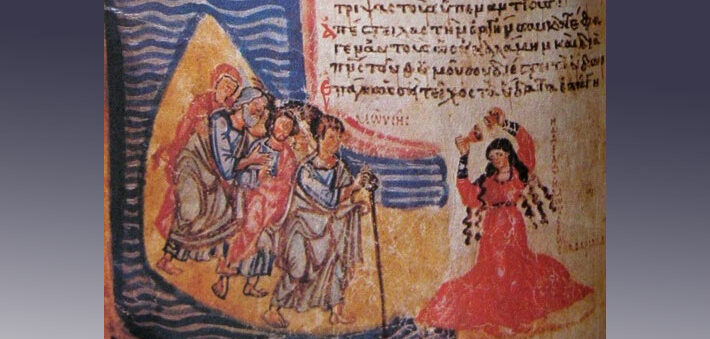Commentary on Ezekiel 36:24-28
Ezekiel is not a very pleasant text.
In fact, the book might be the most thorough instance of “blaming the victim” in the history of world literature. Written as a response to the fall of Jerusalem to the neo-Babylonian empire in 587 BCE, the poems that riddle most of the book take great delight in finding ways to blame the Judeans for their own demise. The passages from Ezekiel that are in the lectionary, however, might lead to a different impression.
This brief passage from the second half of the book looks like God’s loving restoration of Israel. Read in isolation from the rest of the book, the text depicts God’s personal care in returning the exiles and settling them again back in their ancestral territory. God even makes sure that they have a heart for goodness. This is a scene that could dot a nursery room. But just like that other text of terror that often is pedaled as infant-appropriate, Noah’s ark brimming with the animals he saves from world-wide divine devastation, so too this image of restoration in Ezekiel insufficiently covers up the divine wrath to which it responds. A close reading of this text reveals these streams of despair.
Not once in the book of Ezekiel, including in this very passage, does God act out of love for Israel. There is a brief mention of God feeling pity (Ezekiel 39:25), but never love. Even in the elaborate scenes from a dysfunctional marriage in chapters 16 and 23 the texts never claim that God loves these wives. Ezekiel’s wife, whose death serves as a metaphor for the fall of the city, is named his “delight” but the prophet, and therefore God, does not love his respective spouse.
The heart transplant at the center of this passage removes humanity’s free will. This image appears twice in the book, first in chapter 11 and here. It differs slightly, but significantly from the new heart passage in Jeremiah 32:39 where the new heart is tied to covenant loyalty and a renewed relationship with God. Here, the purpose of the new heart is to remove choice from humans. They will not choose to sin because they will no longer have the power to do so. In a kind of reversal of Genesis 3, Ezekiel’s resolution of human sinfulness is a complete change of human nature.
Moral behavior throughout Ezekiel is characterized by observance of the ritual laws that governed the temple. To be sure, moral sins, such as lying and dishonoring parents, resulted in ritual impurity, but the emphasis in this passage on the removal of impurities continues the book’s focus on the destiny of the temple as the most essential feature of Israelite identity.
The passage likens this future forced conversion to ritual law as a kind of re-birth. The heart of stone refers to the internal organs of someone who is dead. In fact, in Egyptian burials, in the process of mummification, they replaced the heart with a stone one. In Egyptian burial scenes, the heart of the deceased is weighed against a feather. Only if it is lighter than a feather will the deceased be able to enter the world of the dead. Otherwise, their heart is devoured and they cease to exist. For the Egyptians, then, sins weighed down the heart: the heavier the heart, the more sinful a person’s life had been. Against this Egyptian background, Ezekiel’s reference to a heart of stone continues the book’s depiction of the Judeans as inherently sinful. This is a heart weighed down by sin, as heavy as a stone. It is a picture of Israel as deservedly annihilated.
Ezekiel 36, then, depicts restoration as a kind of resurrection of the dead, much like the image of the dry bones in the following chapter. In this passage, there is less focus on the restoration of the body, however, and more on resuscitation. After the heart transplant, God enlivens that body through the infusion of the divine spirit. It is, at first blush, a wonderful portrayal of divine grace, but cheap grace it is not.
The passage is framed by two statements that remind Ezekiel’s audience that this is not about God’s love for them, nor does it really have anything to do with them. This is all about God. The first passage occurs in the verse just prior to this reading. There God states that the motivation for this restoration is simply divine reputation: God will restore Israel so that all of the nations of the world will “know that I am Yahweh” (Ezekiel 36:23). God could care less whether Israel lives or dies. There is no heavenly tears shed for this dead nation. Their restoration is simply a sign to the world that this God can do anything.
This idea is supported by the statement in verse 27 in which God states that the purpose of this new heart is to make the people follow God’s laws: “I will … make you follow my statutes.” Not only will Israel be restored to prove that Yahweh is God, but this restored nation, apparently well known for its disobedience to divine law, will now become the paragon of upright behavior, even if this is accomplished by making them law-abiding automatons. The passage continues, and re-states the divine motivation in verse 32, just in case the reader missed it. “It is not for your sake that I will act, says the Lord.” The text’s message is not subtle.
It is interesting, then, that the lectionary has chosen to ignore the blatant message of this passage, excising the most explicit divine statements, in order to turn this into a benign post-Easter message. Perhaps we need to be reminded that the Easter message is not all about us: it is about God and what that God has chosen to do. Can we live in that reality without our own heart transplant?


March 26, 2016